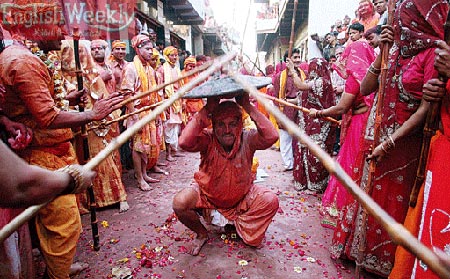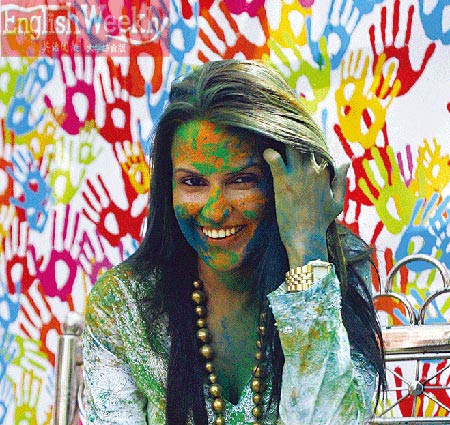|
|
|
Lathmaar Holihttp://www.sina.com.cn
2007年04月03日 00:14 英语周报大学版
拉斯马尔好利节(2006-2007学年 第26期) Lathmaar Holi 郑睿 译
 人们欢度拉斯马尔好利节
 妇女被颜料水浸透祈祷上帝赐福 This colourful festival of Hindus, celebrated on the full moon day in the month of Phalguna, heralds the advent of spring. On this day people visit each others home, distribute sweets and apply gulal on each other signifying the colourful and happy spring time ahead. People throw colourful powder, coloured water on each other through pichkaris. Thandai, a drink made with cannabis, almonds and milk, is extremely popular on this day. The day before Holi is Chotti Holi or small Holi. The main ritual on this day centres around a bonfire ceremoniously kindled at the time of the rising moon. This suggests that the festival is also a celebration of the barley harvest. People start collecting firewood, cowdung and rubbish around a central pole in the locality many days in advance. On Chhotti Holi everyone comes together to light the fire. A pot of new barley seeds is buried under the pyre for roasting. These seeds are eaten after the fire is extinguished. The ashes from the Holy fire are also believed to provide protection against diseases. 这个五彩缤纷的印度教节日,在颇勒窭努月(译者注:公历2、3月间)的望月日庆祝,它预示着春天即将到来。在这天,人们走亲访友,分发糖果,并相互涂抹七彩颜色粉,预示着即将来临的春天将是姹紫嫣红、十分幸福的。人们通过使用水枪互相扔洒各种颜色的粉末、颜料水。桑代, 是一种由大麻、杏仁及牛奶制成的饮料,在这天十分受欢迎。 好利节的前一天是秋蒂好利节或称为小好利节。这一天的主要仪式是,在月亮升起时举行隆重的篝火点燃仪式。这表示,该节日也是庆祝大麦丰收。在仪式举行前一段日子,人们就开始把收集到的柴火、牛粪以及垃圾堆放在仪式举行地的中心柱周围。在秋蒂好利节这一天,所有人都聚集在一起点燃篝火。一罐子大麦种子被埋于柴火下进行烘焙。 在熄火后,人们会吃掉这些种子。人们认为,好利节篝火留下的灰烬还具有防止疾病的作用。 Myth I The origin of this custom can be found in the pranks of Krishna, who used to drench milkmaids in the village with water and play various other tricks on them. Holi festival is not celebrated in South India but a similar festival in the honour of the God of love, Kama, takes place there at the same time. 传说一 这一风俗起源于(印度教)的克利须那神的恶作剧,他曾将村庄中的挤奶女工用水浸湿,然后对她们进行各式各样的捉弄。印度南部并不举行好利节,而是在同一时间举行一个类似的节日,表达人们对于爱神迦摩天的敬意。 Myth II Holi fire is regarded as a funeral pyre for it is understood to have destroyed Holika, a demoness. According to a legend Hiranyakshipu was a demon king. He wanted to avenge the death of his younger brother, who had been killed by Vishnu. He performed severe penance for many years to gain enough power to become the king of the three worlds. So intense was his penance that a smoke billowed from his head and the entire world was in the danger of annihilation. Worried, the Gods ran to Brahma for help. Brahma then appeared before Hiranyakshipu and the demon asked for a boon that he would be killed by neither man nor beast, neither indoors nor outdoors, neither on earth nor in heavens, neither during the day nor at night. Brahma granted him the boon. Believing that he was now invincible, Hiranyakshipu soon became pompous and ordered all his people to worship only him. The demon however, had a son named Prahlad who was ardent devotee of Vishnu. The evil demon decided to kill his own son but each attempt failed. The king then summoned his sister Holika who because of a boon was immune to fire. He prepared a pyre, lit it and asked Holika to sit on it, clutching Prahlad. Vishnu intervened to save Prahlad and evil Holika perished instead. This legend is relived on Chhoti Holi when the pyre is re-lit. Holika also signifies the dirt and filth that collects during the winter months. Hay and old rubbish is thrown into the bonfire. Holi at Mathura and Vrindavana is celebrated with great gusto for many days, as these were the places where Krishna spent most of his childhood. People get drenched with coloured water and consider it as a blessing of God. Holi festival in the village of Barsana 42km from Mathura is of special interest. Radha belonged to Barsana while Krishna hailed from Nandgaon. On Holi, men from Nandgaon come to Barsana to play holi with the women there. Women beat the men with sticks rather than applying gulal. This is called lathmar Holi. In Maharashtra and Gujarat, a grand procession of men soaked with coloured water walks through the streets shouting ‘Govinda ala re, Zara matki sambhal brijbala re!’ This refers to Lord Krishna’s habit of stealing butter and milk stored in terracota pots from people’s homes. As a child Krishna was very fond of milk and milk products. He would prowl into anyone’s house and steal or break pots of butter and milk. During a holi, a pot of buttermilk is hung high up in the street. Men forming a human staircase try to break this pot. In Bengal, holi is called Dol Yatra or the spring yatra. Idols of Radha and Krishna are placed on swings and devotees take turns to swing them. Women dance around the swing and sing devotional songs, as men spray coloured water on them. In Manipur, holi is a six-day festival. The traditional and centuries old Yaosang festival of Manipur amalgamated with Holi in the 18th century with the introduction of Vaishnavism. The entire theme of the festival is woven into the worship of Krishna and Chaitanya Mahaprabhu. Thabal Chongba, a popular Manipuri folk dance is associated with this festival. Instead of a bonfire, a hut is built and then later set ablaze. The next day boys play with gulal with the girls. And in return for playing with them, the girls extract money from the boys. Another significant feature of the festival of Manipur is the groups of devotees from different areas who gather at Shree Govindaji Temple in Imphal. Dressed in the traditional white and yellow turbans, they sing songs in the praise of Krishna and Chaitnaya Mahaprabhu. 传说二 好利节之火被认为是殡葬柴火,这是因为人们认为该火曾消灭了女魔霍利嘉。据说,希兰亚卡西普是一个暴君。他想为遭毗湿奴杀害的弟弟报仇。他苦行多年,获得了足够的功力而成为了三界的国王。他的修行功力十分强大,从他的头上喷出的烟柱会使整个世界处于被毁灭的危险之中。诸神对此十分担心,他们找主神梵天寻求帮助。梵天随即出现在希兰亚卡西普面前,这个暴君要求得到梵天保佑,即他不会被人或者野兽杀死,不会死于室内或者室外,不会死于人间或者天堂,不会死于白天或者黑夜。梵天给予了他这一神灵保佑。 希兰亚卡西普认为,这样他就是不可战胜的了,很快他变得自负,并且命令他的所有子民只对他顶礼膜拜。然而,这个暴君的儿子普拉拉德却是毗湿奴的忠实信徒。暴君决定杀死自己的亲生儿子,但是每次企图都失败了。暴君随即召来了他的妹妹霍利嘉,霍利嘉曾得到神灵保佑不怕火烧。他准备了柴火,点燃后,要求霍利嘉坐上去,并且紧紧抱住普拉拉德。毗湿奴挺身拯救了普拉拉德,而邪恶的霍利嘉则被毁灭。 人们在秋蒂好利节,重燃柴火,再次体验这个传说。霍利嘉也象征着冬季里积存了的污垢。干草与旧垃圾则被扔入篝火之中。 在马图拉与温达文纳,人们以极大的热情来庆祝好利节,节日会持续多天。因为克利须那神在这些地方曾度过了他大部分的童年时光。 人们被颜料水所浸透,认为这是上帝的赐福。在距马图拉 42公里的巴尔萨纳村举行的好利节则具有特殊意义。克利须那神来自南德冈,而那时罗陀属于巴尔萨纳。在好利节,南德冈的男人来到巴尔萨纳,与那里的女人嬉戏。女人用木棒打男人,而不是涂抹七彩颜色粉。这被称为拉斯马尔好利节。 在马哈拉施特拉邦与古吉拉特邦,浸透颜料水的男人们会举行盛大的游行,穿过街道,并且大声喊叫“Govinda ala re, Zara matki sambhal brijbala re!”这与克利须那神从人们家里的陶瓦罐中偷窃黄油与牛奶相关。克利须那神小的时候,十分喜欢牛奶与牛奶制品。他会潜入他人屋内,偷窃或者打碎黄油与牛奶罐。在好利节,一个黄油与牛奶罐会被高高悬挂在大街上。男人们组成人梯,试图打碎这个罐子。 在孟加拉,好利节被称为多尔朝圣期或者春天朝圣期。罗陀与克利须那神的神像则被摆放在秋千上,信徒们轮流摇动秋千。女人们围着秋千跳舞,并唱着虔诚的歌曲,而男人们则将颜料水拨洒在女人们身上。 在曼尼普尔邦, 好利节是一个为期6天的节日。该节日在18世纪与传统的、具有几个世纪历史的曼尼普尔尧桑节合为一体,节日引入了毗湿奴崇拜概念。节日的整个主题是营造对克利须那神与柴坦亚•玛哈帕布的崇敬氛围。塔巴尔昌巴是与该节相关的、广受欢迎的曼尼普尔邦民间舞蹈。这里树起的是一间茅屋,而不是篝火,然后人们将茅屋点燃。第二天,男孩与女孩一同玩耍七彩颜色粉。作为与男孩们玩耍的回报,女孩们通常会向男孩收钱。该节在曼尼普尔的另一个重要特征是,来自不同地区的一批批信徒会聚集到位于英帕尔的什里高文塔姬寺庙。他们头戴传统黄白头巾,唱着称颂克利须那神与柴坦亚•玛哈帕布的歌曲。
【发表评论】
|